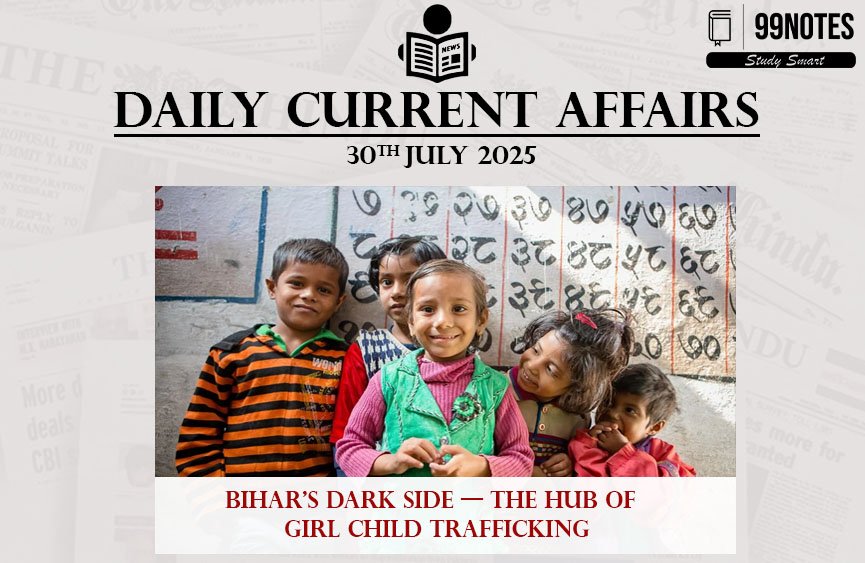30 July 2025 : Daily Current Affairs
1. Interrupted Growth – Industrial growth is still tied to government spends on infrastructure
Source: Page 6 , The Hindu UPSC IAS Edition
| Topic: GS-3 (Indian Economy – Growth & Development, Infrastructure, Climate Change & Economy) |
| Context |
|
Content
Key Points:
-
IIP Growth: June’s Index of Industrial Production grew at 1.5%, the lowest in 10 months. Mining output shrank by –8.7% and electricity generation by –2.6%, sharply contrasting with growth figures from previous years.
-
Climatic Disruption: Uneven and intense rainfall led to water-logging in mining regions (Odisha, Jharkhand, West Bengal), affecting mineral extraction and electricity supply chains.
-
Infrastructure Dependence: Capital, intermediate, and infrastructure goods output saw relatively robust expansion, showing that government infrastructure spending is currently the main driver of industrial growth.
-
Systemic Challenges: Indian statistical agencies are reluctant to explicitly link such economic underperformance to climate-related events; climate risk attribution is still not mainstreamed in routine macroeconomic reporting.
-
Comparative Context: Central banks like the ECB and Bank of England have begun integrating climate risk into economic analysis, but India’s production-side data still lacks this framework.
-
Policy Analysis: The editorial calls for a systemic shift in India to integrate climate attribution into macroeconomic indicators for better policy response and risk management.
Analysis:
-
Climate and Economy Link: Ignoring climate change effects in economic data can lead to misinformed policy decisions; climate events can cause “structural shocks” to critical sectors.
-
Policy Recommendations:
-
Urgent need for climatological impact frameworks within economic data and policy.
-
Enhanced infrastructure to reduce vulnerability to erratic weather — robust supply chains, diversified sourcing, disaster-resilient infrastructure.
-
Investment in green and adaptive technologies to mitigate climate-induced supply disruptions.
-
Practice Question:
|
“Discuss the impact of climate variability on industrial growth in India, with reference to recent trends in the mining and power sectors. What policy responses are necessary to better integrate climate risk into India’s macroeconomic planning?” (250 words / 15 marks) |
2. Bihar’s dark side — the hub of girl child trafficking
Source: page 6, The Hindu UPSC IAS Edition
| Topic: GS-1 (Society: Human Trafficking, Social Issues), GS2 (Governance, Child Rights), GS4 (Ethics in Governance) |
| Context |
|
Analysis from UPSC Angle:
Key Points:
-
Scale of Trafficking: 271 girls rescued till June 2025; trafficking for “orchestra” performances and flesh trade; Saran district is a hotspot.
-
Root Causes: Regulatory gaps, societal acceptance, poverty, porous borders with Nepal, ease of transport across State lines.
-
Vulnerability Factors: Parents lured by false promises (arts, jobs, marriage), poverty, geography, and weak local governance.
-
Systemic Failures:
-
Conviction rates extremely low.
-
Anti-Human Trafficking Units (AHTUs) are under-resourced; cases collapse due to multi-State jurisdictional issues.
-
Rescued girls often sent back to families involved in their trafficking.
-
-
Legal Landscape: Comprehensive laws exist (POCSO, Immoral Traffic Prevention, Bonded Labour, Child Labour Prohibition Acts), but enforcement is patchy.
-
Policy Suggestions:
-
Ban on minors in orchestras; map and regulate such groups.
-
Transport vigilance; train RPF, bus operators for monitoring.
-
Strengthen, properly staff, and make AHTUs accountable.
-
Long-term, state-supervised rehabilitation; victim compensation enforced.
-
Prosecution as a tool for deterrence and ending the trafficking system.
-
Preventive strategy: PICKET (Policy, Institutions, Convergence, Knowledge, Economy, Technology).
-
-
Analytical Insight:
-
Trafficking persists due to systemic, not individual, failure — requiring convergence of policy, vigilance, law enforcement, and community awareness.
-
Practice Question:
|
“Critically analyse the major factors contributing to girl child trafficking in India. Suggest a comprehensive multi-pronged approach for prevention, protection, and rehabilitation of child trafficking victims.“ (250 words / 15 marks) |
3. Why the Gini Index is wrong about India
Source: Page 7, Indian Express Delhi Edition
| Topic: GS-1 (Society: Inequality), GS2 (Social Justice), GS3 (Inclusive Growth) |
| Context |
|
Key Points for UPSC:
Key Points:
-
Contradiction: Gini Index assigns India a low inequality score (25.5), but practical observation reveals major disparities in wealth, gender, digital access, and education.
-
Wealth Inequality: The top 1% owns 22.6% of national income; informal sector prevalence means much of the population, especially the poor, is not captured in formal data.
-
Gender Inequality: Women’s workforce participation is just 35.9%; women hold only 12.7% senior management roles and merely 7.5% of startups are women-led.
-
Digital Divide: Only 52.7% of schools have computers; internet access is 53.9% in schools, and only 41.8% households have broadband.
-
Interlinked Disadvantages: Digital inequality further deepens gender and educational inequality, especially among rural and female populations.
-
Critical Analysis: Current data and rankings obscure the actual extent and forms of inequality, hindering the goal of achieving true equality of opportunity.
Practice Question:
|
“Critically discuss the limitations of global inequality indices like Gini in assessing India’s socio-economic reality. Suggest better measures for understanding and addressing inequality in India.” (150 words / 10 marks) |
Check more: 29 July 2025 : Daily Current Affairs


